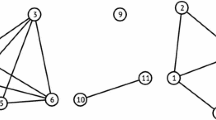Abstract
Mobile ad-hoc network (MANET) is a theoretical and experimental approach for achieving the applications to the best using VANETs. Given the mobility of nodes in the mobile ad-hoc networks, it is hard to depict the nature of the network or the structure of the network. With static nodes, it is easy to monitor a network. In a mobile environment, any node can come and join the network based on the distance covered by the entire network. A node that enters the region joins the network, while one that moves away leaves it and ceases participating in network communication. The routing table is updated, based on the movement of the nodes. Owing to the factors above, security fails to live up to expectations. Identifying a vulnerable node is a difficult proposition. This paper offers a prediction model based on the delay factor, which impacts the performance of the node and its network. The experimental results determine the malicious node. A malicious node is disconnected from the network.



Similar content being viewed by others
7. References
Ahmed MN et al (2017) F3TM: flooding factor-based trust management framework for secure data transmission in MANETs. J King Saud Univ Comput Inf Sci 29(3):269–280
Aluvala S et al (2016) A novel technique for node authentication in mobile ad hoc networks. Perspect Sci 8:680–682
Angelov P, Gu X, Kangin D (2017a) Empirical data analytics. Int J Intell Syst 32(12):1261–1284
Angelov P, Gu X, Kangin D, Príncipe JC (2017b) Empirical data analysis: a new tool for data analytics. In: 2016 IEEE international conference on systems, man, and cybernetics, 2017
Angelov P, Gu X, Príncipe JC (2017c) A generalized methodology for data analysis. IEEE Trans Cybern 48(10):2981–2993
Angelov P, Gu X, Príncipe JC (2017d) Autonomous learning multimodel systems from data streams. IEEE Trans Fuzzy Syst 26(4):2213–2224
Aquino G et al (2020) Novel nonlinear hypothesis for the delta parallel robot modeling. IEEE Access 8(1):46324–46334
Arnaud M, Cortier V, Delaune S (2014) Modeling and verifying ad hoc routing protocols. Inf Comput 238:30–67
Batabyal S, Bhaumik P (2015) Mobility models, traces and impact of mobility on opportunistic routing algorithms: a survey. IEEE Commun Surv Tutor 17(3):1679–1707
Bezerra CG et al (2016) An evolving approach to unsupervised and real-time fault detection in industrial processes. Expert Syst Appl 63:134–144
Chen I-R, Guo J, Bao F, Cho J-H (2014) Trust management in mobile ad hoc networks for bias minimization and application performance maximization. Ad Hoc Netw 19:59–74
Conti M et al (2015) From MANET to people-centric networking: milestones and open research challenges. Comput Commun 71(1):1–21
Costa BSJ et al (2014) Real-time fault detection using recursive density estimation. J Control Autom Electr Syst 25:428–437
deJesús Rubio J (2009) SOFMLS: online self-organizing fuzzy modified least-squares network. IEEE Trans Fuzzy Syst 17(6):1296–1309
Elias I (2020) Hessian with mini-batches for electrical demand prediction. Appl Sci 10(6):2036
Govindan K, Mohapatra P (2011) Trust computations and trust dynamics in mobile ad hoc networks: a survey. IEEE Commun Surv Tutor 14(2):279–298
Hongsong C et al (2007) Design and performance evaluation of a multi-agent dynamic lifetime security scheme for AODV routing protocol. J Netw Comput Appl 30:145–166
Kumar V (2015) An adaptive approach for detection of blackhole attacks in mobile ad hoc network. Procedia Comput Sci 48:472–479
Mafra PM et al (2014) Algorithms for a distributed IDS in MANETs. J Comput Syst Sci 80(3):554–570
Maity S et al (2014) Self-organized public key management in MANETs with enhanced security and without certificate chains. Comput Netw 65:183–211
Masdari M et al (2017) Markov chain-based evaluation of the certificate status validations in hybrid MANETs. J Netw Comput Appl 80:79–89
Meda-Campaña JA (2018) On the estimation and control of nonlinear systems with parametric uncertainties and noisy outputs. IEEE Access 6:31968–31973
Mitchell R, Chen I-R (2014) A survey of intrusion detection in wireless network applications. Comput Commun 42:1–23
Panos C et al (2017) Analyzing, quantifying, and detecting black hole attacks in infrastructureless networks. Comput Netw 113(11):94–110
Rajkumar B, Narsimha G (2016) Trust-based certificate revocation for secure routing. In: MANET’, procedia computer science, vol 92, pp 431–441
Raza I, Hussain SA (2008) Identification of malicious node in an AODV pure ad hoc network through guard nodes. Comput Commun 31:1796–1802
Rmayti M (2017) A stochastic approach for packet dropping attack detection in mobile ad hoc networks. Comput Netw 121(5):53–64
Sánchez-Casado L (2015) A model of data forwarding in MANETs for lightweight detection of malicious packet dropping. Comput Netw 87(20):44–58
Saranya V (2015) Study of various routing protocols in MANETs. Int J Netw Virtual Organ 15(4) Published online
Su M-Y (2011) Prevention of selective black hole attacks on mobile ad hoc networks through intrusion detection systems. Comput Commun 34:107–117
Xuanxia Y (2017) Using a trust model to ensure reliable data acquisition in VANETs. Ad Hoc Netw 55:107–118
Author information
Authors and Affiliations
Corresponding author
Additional information
Publisher's Note
Springer Nature remains neutral with regard to jurisdictional claims in published maps and institutional affiliations.
Rights and permissions
About this article
Cite this article
Gayathri, V.M., Supraja, P. Identification and eradication of attacker node in a mobile ad-hoc network environment using prediction model on delay factor. Evolving Systems 12, 233–238 (2021). https://doi.org/10.1007/s12530-020-09358-x
Received:
Accepted:
Published:
Issue Date:
DOI: https://doi.org/10.1007/s12530-020-09358-x




